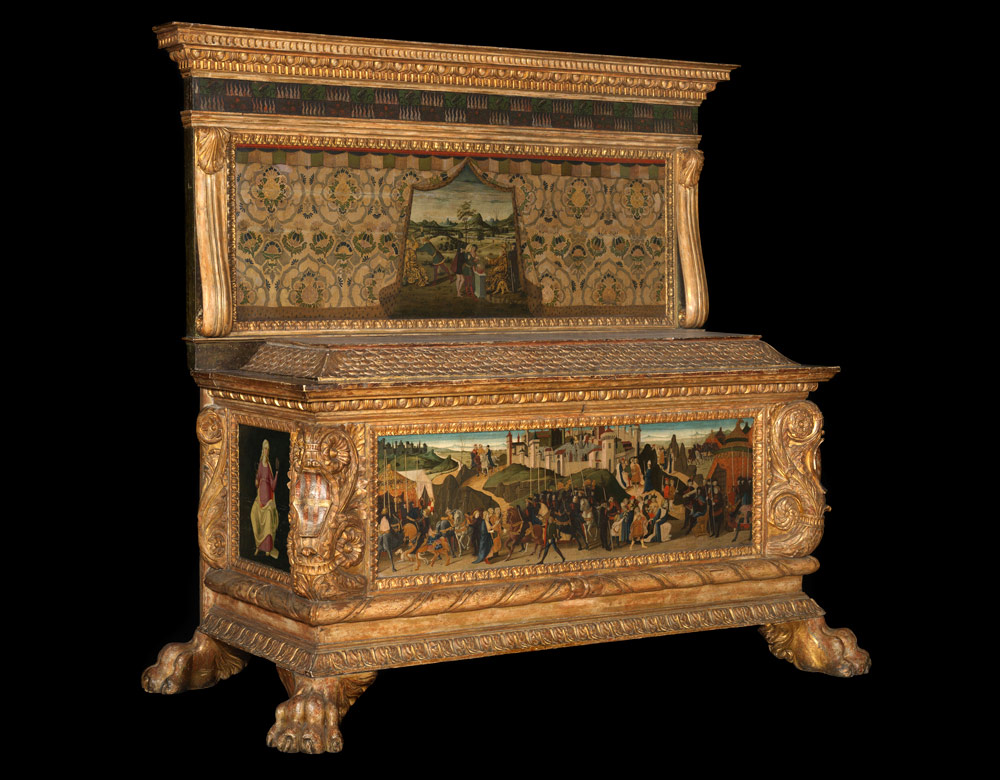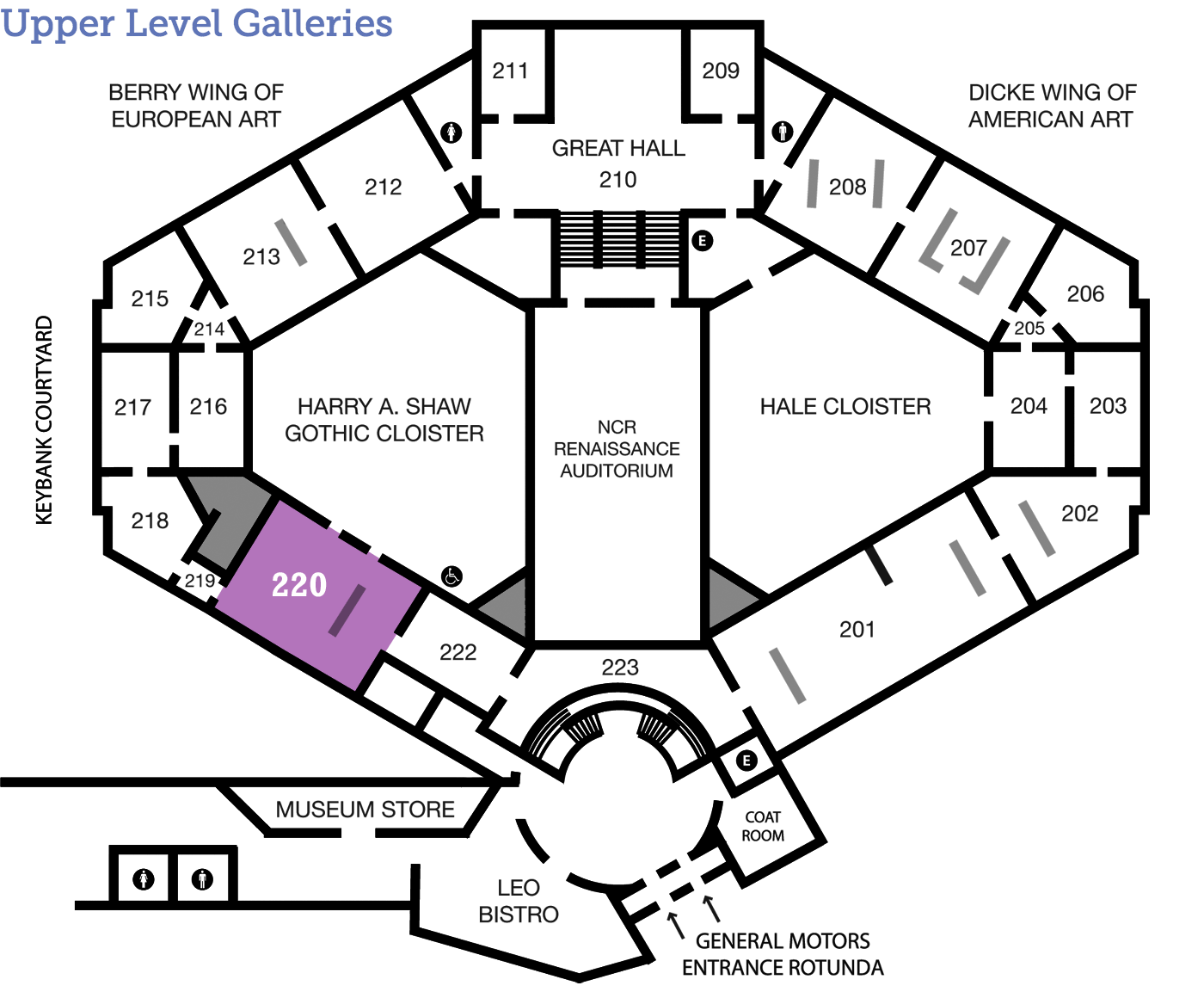
Master of Marradi
Judith and Holofernes
(active 15th century)
Italian 15th century tempera on wood panel 15¾ x 58½ in. Gift of Mr. and Mrs. Ralf Kircher 1964.10
Here Comes the Bride
This panel once formed one side of a bride’s wedding chest. Pairs of these chests, or cassoni, were carried in processions through the city on a bride’s wedding day. The apocryphal story of the beautiful widow Judith beheading the invading Assyrian general Holofernes adorns this particular panel, possibly instructing the new bride to be virtuous and honorable.
A Day in the Life
Marriage in Renaissance Florence
This panel originally formed one side of a cassone, or painted wedding chest. Pairs of cassoni were commissioned by a groom’s family to house the bride’s trousseau, or what we might call her dowry. Today we rarely see them in their original three-dimensional compositions, much less fulfilling their intended roles. Instead, we view cassone panels as individual paintings in museums all over the world.
Below is an image of a surviving cassone, the Nerli Cassone at The Courtauld Gallery in London.

Zanobi di Domenico (act, 1472) and Sellaio, Jacopo del (1441/2-1493): Nerli Cassone, 1472, wood and gesso and tempera and gilding, cassone: 109.2 x 193 x 76.2 cm, spalliera: 102.8 x 193 cm, overall height: 212 cm, collection of The Courtauld Gallery.
Used with permission from The Samuel Courtauld Trust, The Courtauld Gallery, London.
Tools and Techniques
Behind the Scenes
Look Closer
Painting Time
In this painting, time is demonstrated through repetition. The story can be read in counter-clockwise direction, beginning in the bottom right corner. Judith and her servant are shown three times: decapitating Holofernes; escaping the Assyrians’ camp; and fleeing back into Bethulia. The citizens of Bethulia then rush from the city and engage the Assyrians in battle in the foreground.
This use of repetition of forms to convey the progression of events is common in fifteenth-century Florentine painting.
Just for Kids
Signs & Symbols
Dig Deeper
Arts Intersected
The Story of Judith
The Book of Judith is an apocryphal book of the Old Testament, meaning it is included in the Roman Catholic and Eastern Orthodox Bibles, but excluded from Jewish and Protestant texts.
Judith, a revered and beautiful widow, lived in the city of Bethulia, which was under siege by the Assyrian army. The leaders of Bethulia decided to surrender to the powerful Assyrians. Rather than seeing her city fall to the violent intruders, Judith traveled to the camp of the enemy general Holofernes and seduced him, plying him with wine. As he lay in a drunken stupor, Judith cut off Holofernes’s head and returned with it to her grateful countrymen. The Israelites then rushed from Bethulia and conquered the weakened Assyrian army.
Additional Information: Text adapted from: New World Encyclopedia. “Book of Judith.” Accessed 17 July 2014. http://www.newworldencyclopedia.org/entry/Book_of_Judith.
The Sculpture Speaks
Did You Know?
Expert Opinion
The Object
Dr. Roger Crum, scholar of Renaissance Florentine art and Professor of Art History at the University of Dayton, discusses the cassone’s function at the time of its creation as well as its contemporary role on display in museums.
What was a cassone and how did it function?
How were cassoni purchased and made in 15th century Florence?
Transcript 1:
Works of art in art museums often have fascinating histories, and certainly one object that I find in the collection of The Dayton Art Institute that has quite a long and interesting history is this object here behind me. It is a Florentine, 15th-century object. We see the object here in the museum as it is displayed hanging on a wall. That, of course, is the way that we understand and we want to see and appreciate this object from our modern and contemporary perspective of this object as a work of art.
When this object was made, however, it would have been seen in a very different manner. It would not have been seen on a wall. In fact, it would have been seen closer to the ground. For what we’re looking at here is a painted object, a painted surface, that was originally one surface of a storage box called a cassone chest.
Cassone chests were made in duplicates for married couples—actually for the bride in the context of a wedding. They would have been commissioned in 15th-century Florence by the groom and the groom’s family to be given to the bride on the occasion of the wedding. Typically, they were long, rectangular objects into which a bride would place her valuable items, her trousseau. These chests were carried ceremoniously from the bride’s house to the groom’s house on the day of the wedding.
Transcript 2:
These objects would have already had a kind of journey through the city, for in the very process by which they were made, their manufacture would have been a collaboration between a carpentry workshop and a painting workshop. Painters very typically would engage a carpenter to make an object that then needed to be painted. In this case, the cassone would be commissioned first of a carpenter who would make what is essentially like a cedar chest. Then this chest would be delivered to a painter’s workshop.
Before all this happened, however, a specific individual—we would call this individual the patron—would visit the painter and engage that painter in some kind of a conversation, ultimately leading to a contract in which there would be some stipulation that could be of a very general nature—"I commission this painter to make two cassone chests." It could go even further to the specification of subject matter.
Typically, these cassone chests were decorated with two levels of decoration. One level of decoration would’ve simply been the heraldic—very often on the ends of the box one might find coats of arms of the two families being united in the marriage ceremony. A second level of decorative material would be the actual subjects of the paintings. Typically they would be subjects of virtuous deeds from either the Bible or ancient Roman or Greek history. Very often these subjects would be quite specifically dealing with the virtuous deeds of women.
Look Around
About the Artist
Talk Back
A Grisly Subject!
The story of Judith and Holofernes is undeniably a gruesome one. Does it surprise you that this subject would be painted on a wedding chest? What other stories might you expect to see?

